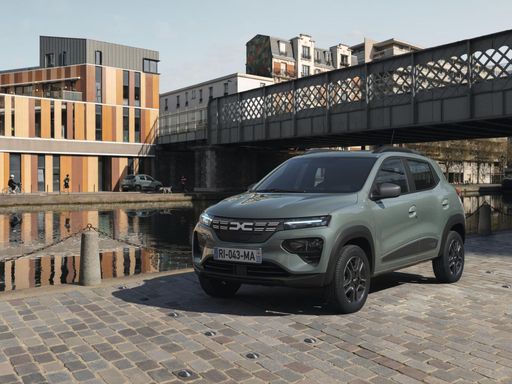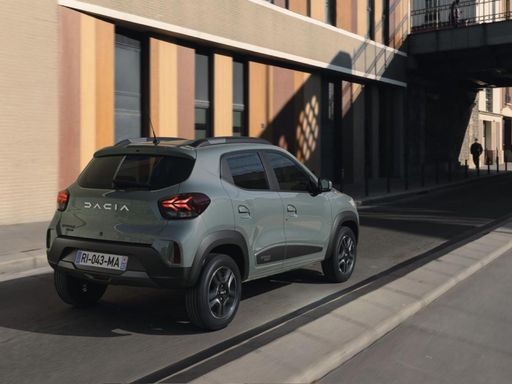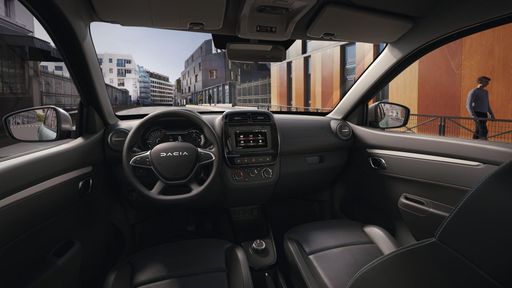Micro Microlino VS Dacia Spring – Specs, Efficiency & Price Comparison
Which model is the better choice – the Micro Microlino or the Dacia Spring? We compare performance (17 HP vs 65 HP), boot capacity (230 L vs 308 L), efficiency ( vs 13.20 kWh), and of course, the price (15400 £ vs 14500 £).
Find out now which car fits your needs better!
The Micro Microlino (Hatchback) is powered by a Electric engine and comes with a Automatic transmission. In comparison, the Dacia Spring (SUV) features a Electric engine and a Automatic gearbox.
When it comes to boot capacity, the Micro Microlino offers 230 L, while the Dacia Spring provides 308 L – depending on what matters most to you. If you’re looking for more power, you’ll need to decide whether the 17 HP of the Micro Microlino or the 65 HP of the Dacia Spring suits your needs better.
There are also differences in efficiency: vs 13.20 kWh. In terms of price, the Micro Microlino starts at 15400 £, while the Dacia Spring is available from 14500 £.
Compare all the key specs now and find out which model fits your lifestyle best!
In the realm of ultra-compact urban electric vehicles, the Dacia Spring and Micro Microlino both present compelling yet distinct propositions for city dwellers. The Dacia Spring offers a practical, five-door layout with adequate space for small families, focusing on affordability and simplicity, whereas the quirky, retro Microlino appeals to those seeking a unique, scooter-inspired design and maneuverability in tight city spaces. Both vehicles promise to redefine urban mobility, with the Micro Microlino prioritizing style and the Dacia Spring emphasizing practicality and access for everyday use.
Micro Microlino
The Micro Microlino stands out as a charming urban microcar, seamlessly blending retro design with modern functionality. Its compact size makes it perfect for navigating busy city streets, while the environmentally friendly electric drive offers a sustainable alternative to traditional vehicles. Inside, drivers will find a surprisingly spacious and minimalist interior, designed for comfort and ease of use.
detailsDacia Spring
The Dacia Spring stands out as an affordable and environmentally friendly option in the electric vehicle market, combining practicality with a compact design ideal for urban settings. Its minimalist interior, while basic, provides all the essential features needed for a comfortable drive, reflecting its cost-effective approach. The vehicle's performance suits city driving, making it an appealing choice for those seeking an entry-level electric car.
details @ dacia-presse.de
@ dacia-presse.de
 @ dacia-presse.de
@ dacia-presse.de
 @ dacia-presse.de
@ dacia-presse.de
The Compact Crossover: Dacia Spring
The Dacia Spring is an SUV that defies expectations with its eco-friendly electric engine and practical design suited for urban and suburban adventures. Introduced in the 2024 model year, it comes equipped with a compact yet efficient electric setup. The Spring features a front-wheel-drive system powered by a modest 44 to 65 HP motor, offering an electric range up to 228 km depending on the usage.
Under the hood, the Dacia Spring utilizes a reduction gearbox which perfectly complements its automatic transmission. It's optimized for city commuting with a manageable 125 km/h top speed and an acceleration of 0-100 km/h in 13.7 to 19.1 seconds. The SUV also boasts a substantial 125 to 113 Nm of torque, providing adequate power for its size.
The Elegant Urban Cruiser: Micro Microlino
Putting a fun spin on city driving, the Micro Microlino presents itself as a gallant hatchback that brings innovation to the forefront of urban mobility. Also a 2024 entry, this vehicle prides itself on rear-wheel-drive capabilities, sporting a powertrain that generates between 8 to 17 HP. Its design is streamlined for efficiency with an appreciable electric range extending from 93 km up to an impressive 228 km.
The Microlino is engineered for the modern city dweller, achieving a top speed of 90 km/h. With a torque output of 89 Nm, its performance might not break records but promises a smooth ride through congested city streets. The hatchback's automatic transmission ensures that those rides are relaxed and comfortable.
Space and Practicality: Head-to-Head
Space is one of the main differentiators between these two electric vehicles. The Dacia Spring, with its SUV body type, offers greater flexibility with five doors and seating for four passengers. It provides a trunk capacity of 308 liters, making it ideal for small families and those who appreciate extra room for luggage or groceries.
Conversely, the Micro Microlino caters to minimalist urban travelers. Its compact two-door design is complemented by seating for two. While its 230-liter trunk capacity is less than the Spring, the Microlino focuses on superior maneuverability and easier parking in tight city spaces.
Weighing the Environmental Benefits
Both the Dacia Spring and the Micro Microlino excel in sustainability, boasting a CO2 efficiency class of A. Crucially, their electric motors emit zero CO2 emissions, advancing the shift to green urban transportation. The Spring's battery capacity stands at 26.8 kWh, balancing range and weight effectively with curb weights between 1030 to 1050 kg.
The lighter Microlino turns heads with an ultra-light construction, tipping the scales at around 513 to 530 kg, making it one of the lightest vehicles in its class. This reduced weight contributes favorably to its agility and energy efficiency, which is an attractive proposition for eco-conscious consumers.
The Verdict: Innovation and Purpose
The choice between the Dacia Spring and the Micro Microlino depends largely on individual needs. For those seeking a broader utility with room for the family or weekend adventures, the Spring stands out as a practical yet efficient choice. For city enthusiasts who prioritize maneuverability, style, and a minimalist approach, the Microlino offers a unique driving experience that encapsulates these ideals beautifully.
Both vehicles symbolize the future of urban transport, showcasing what can be achieved when function meets an environmentally-forward design philosophy. The Spring and Microlino provide excellent examples of how electric vehicles can be tailored to meet diverse lifestyles without compromising on green credentials.

|
|
|
|
|
Costs and Consumption |
|
|---|---|
|
Price
15400 - 19300 £
|
Price
14500 - 17100 £
|
|
Consumption L/100km
-
|
Consumption L/100km
-
|
|
Consumption kWh/100km
-
|
Consumption kWh/100km
13.2 - 14.1 kWh
|
|
Electric Range
93 - 228 km
|
Electric Range
225 - 228 km
|
|
Battery Capacity
-
|
Battery Capacity
26.80 kWh
|
|
co2
0 g/km
|
co2
0 g/km
|
|
Fuel tank capacity
-
|
Fuel tank capacity
-
|
Dimensions and Body |
|
|---|---|
|
Body Type
Hatchback
|
Body Type
SUV
|
|
Seats
2
|
Seats
4
|
|
Doors
2
|
Doors
5
|
|
Curb weight
496 - 530 kg
|
Curb weight
1013 - 1050 kg
|
|
Trunk capacity
230 L
|
Trunk capacity
308 L
|
|
Length
2519 mm
|
Length
3701 mm
|
|
Width
1473 mm
|
Width
1583 mm
|
|
Height
1501 mm
|
Height
1519 mm
|
|
Payload
220 - 254 kg
|
Payload
265 - 302 kg
|
Engine and Performance |
|
|---|---|
|
Engine Type
Electric
|
Engine Type
Electric
|
|
Transmission
Automatic
|
Transmission
Automatic
|
|
Transmission Detail
-
|
Transmission Detail
-
|
|
Drive Type
Rear-Wheel Drive
|
Drive Type
Front-Wheel Drive
|
|
Power HP
8 - 17 HP
|
Power HP
44 - 65 HP
|
|
Acceleration 0-100km/h
-
|
Acceleration 0-100km/h
13.7 - 19.1 s
|
|
Max Speed
45 - 90 km/h
|
Max Speed
125 km/h
|
|
Torque
89 Nm
|
Torque
113 - 125 Nm
|
|
Number of Cylinders
-
|
Number of Cylinders
-
|
|
Power kW
6 - 12 kW
|
Power kW
33 - 48 kW
|
|
Engine capacity
-
|
Engine capacity
-
|
General |
|
|---|---|
|
Model Year
2024
|
Model Year
2024
|
|
CO2 Efficiency Class
A
|
CO2 Efficiency Class
A
|
|
Brand
Micro
|
Brand
Dacia
|
Micro Microlino
Introducing the Micro Microlino: A Revolutionary Electric Vehicle
The Micro Microlino is a groundbreaking addition to the world of electric vehicles. Combining vintage charm with modern innovation, this compact car has captured the imagination of eco-conscious drivers. With its unique design, impressive performance statistics, and commitment to sustainability, the Microlino offers a bold new direction for urban transport.
Compact Design with Maximum Efficiency
The Microlino features a distinctive hatchback body style and ultra-compact dimensions, measuring just 2,519 mm in length, 1,473 mm in width, and 1,501 mm in height. This allows it to navigate tight urban spaces with ease, making it an ideal choice for city dwellers.
Despite its compact size, the Microlino offers a surprising amount of interior space, comfortably seating two passengers and providing 230 litres of cargo capacity. This efficient use of space is one of the many ways the Microlino innovates over traditional vehicle designs.
Innovative Electric Performance
The Microlino is designed with sustainability in mind, featuring a fully electric powertrain and a range of battery options to suit different needs. Offering a power output between 12 and 17 PS, the car is available with various battery capacities, affording a maximum electric range of up to 228 km on a single charge.
With a torque of 89 Nm and a top speed varying between 45 and 90 km/h, the Microlino ensures lively city driving without compromising on efficiency. The availability of a simple automatic transmission with a reduction gear adds to the ease of driving this innovative vehicle.
A Commitment to Sustainability
The Microlino is at the forefront of sustainable mobility, boasting a CO2 efficiency class of A and producing zero emissions during operation. This aligns with the broader shift towards reducing environmental impact through innovative vehicle technologies.
The vehicle’s lightweight construction, with a weight ranging from 496 to 530 kg, contributes to its efficiency, enhancing battery performance and extending its usable range. It’s a vehicle that doesn't just promise sustainability but delivers on it.
Affordability Meets Modern Features
With a price range of €17,990 to €22,490, the Microlino is competitively positioned, offering affordability alongside its pioneering features. The Microlino comes in different trims, including the Lite and Pioneer Series, each offering a rich set of features that ensure comfort and convenience while prioritising sustainability.
Advanced safety features and modern comforts are built into the Microlino, providing peace of mind alongside a pleasurable driving experience tailored to modern urban needs.
A Modern Icon for Urban Mobility
The Micro Microlino is more than just a car; it's a statement of forward-thinking design merging with practical urban mobility. By focusing on innovative design, sustainable performance, and urban utility, the Microlino represents the future of personal urban transport.
As cities across the globe continue to grow and evolve, the Microlino stands ready as a solution to modern challenges, offering an eco-friendly alternative without sacrificing style or function. It's truly an icon for today’s environmentally conscious driver, combining the best of the past with the promise of the future.
Dacia Spring
The Revolution of Affordable Electric Mobility: The Dacia Spring
The automotive world has witnessed remarkable advancements in electric vehicles (EVs), with the Dacia Spring emerging as a noteworthy contender in the affordable segment. Combining efficiency, affordability, and practicality, the Spring offers an intriguing prospect for eco-conscious individuals and city dwellers alike.
Powertrain and Performance: A Look Under the Hood
The Dacia Spring is equipped with an electric motor that delivers between 44 to 65 PS, translating into a versatile driving experience tailored to urban landscapes. It operates on a front-wheel-drive system, ensuring a familiar and manageable handling experience.
Dacia Spring's electric engine is paired with an automatic transmission, utilising a reduction gearbox. This setup allows for smooth acceleration and a top speed of 125 km/h, ensuring that everyday driving scenarios are handled with ease.
Efficiency and Range: Eco-Friendly without Compromise
Efficiency is a cornerstone of the Dacia Spring's design, boasting an energy consumption of just 13.2 to 14.1 kWh per 100 km. When fully charged, its 26.8 kWh battery offers a respectable range of 225 to 228 km, making it ideal for daily commutes and short trips.
Furthermore, the Spring takes pride in its commendable CO2-efficiency class A, emphasising its commitment to reducing environmental footprint with a zero-emission profile.
Design and Practicality: Compact yet Comprehensive
Lying in the SUV category, the Dacia Spring is compact with dimensions of 3701 mm in length and 1583 mm in width, making it a perfect match for urban environments where space is at a premium. Despite its modest size, it provides a generous boot space of 308 litres, ensuring practicality isn’t sacrificed.
Comfort and Interior: For the Everyday Journey
The Dacia Spring comfortably seats up to four passengers. The cabin offers a minimalist yet functional design, available in multiple trim lines including Essential, Expression, and Extreme, allowing customers to choose according to their taste and requirement.
With its ergonomic layout and simplicity, the interior is crafted to enhance the driving experience by focusing on essential needs, avoiding unnecessary distractions.
Affordability and Accessibility: Breaking Barrier
The Dacia Spring stands out in the electric vehicle market due to its affordability, with prices ranging from 16,900 to 19,900 €. This ensures that environmentally friendly transportation is accessible to a broader audience.
Additionally, the Spring allows for cost-effective maintenance and operational expenses, offering monthly running costs between 570 to 599 € and cost per km between 22.8 to 24 cents, making it an economical choice in the long run.
Final Thoughts: The Future of Urban Mobility
In summary, the Dacia Spring serves as a testament to how electric vehicles can be both affordable and practical, without compromising on essential features. Whether it is for the eco-conscious urbanite or those looking for a cost-effective daily driver, the Spring is positioned as a viable solution for navigating the future of urban mobility.
The prices and data displayed are estimates based on German list prices and may vary by country. This information is not legally binding.
